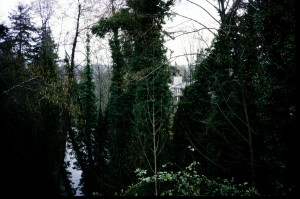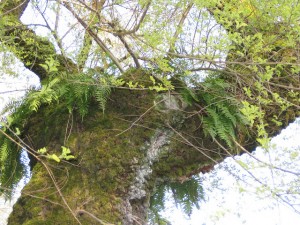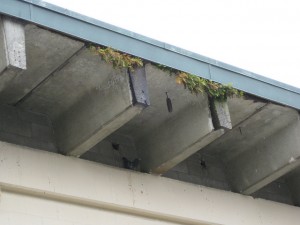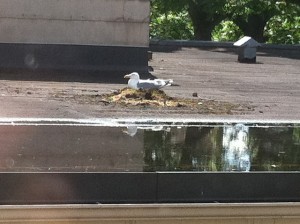Much has been made of the damage caused to ecosystems by so called ‘exotic’ species but things can get pretty complicated when you look at them more closely, particularly in urban environments, where the built landscape so obscures the preexisting ecological underpinnings that all kinds of strangeness can result.
During the early days of Cottonwood Gardens, we had a hard time growing such common natives as Oregon grape (Mahonia) and Salal (Gaultheria) because growing conditions were too hot and dry and the degraded urban soil too alkaline for the comfort of these native woodland plants. Even the ubiquitous Red alder (Alnus rubra) hadn’t yet managed to move in, though it flourishes in the Grandview Cut, just a mile or two away. Instead what had established itself was a so-called ‘ragamuffin’ ecology dominated by exotics such as Black locust (Robinia pseudoacacia), Himalayan blackberry (Rubus discolor), tansy (Tanacetum) and Scotch broom. Black cottonwoood (Populus) was the only native growing widely on the site, though I did find one stressed-out looking clump of sword fern and a straggly Nootka rose hidden among the dense thickets of blackberries.
In the intervening 20 or so years, conditions at Cottonwood Gardens gradually changed enough to allow the establishment of native species, due largely to the increased humidity under the maturing canopy of trees and the soil becoming more acid with the accumulated inputs of leaves and compost. Yet is this natural? Of course not. It was a completely man-made intervention, albeit one that might well provide ecological benefits such as furnishing habitat for native butterflies and other pollinators. I would argue that Cottonwood’s combination of native and exotic species is a ‘hyperecology,’ potentially more ecologically diverse than the native ecology that long ago preceded it. On my several visits to Cottonwood this year I was once again delighted to see bald eagles, icons of British Columbia’s wilderness, soaring over the exotic groves of Chinese chestnut, Paulownia and bamboo. It is important though to note that the native keystone species, Black cottonwood, is still part of the system and indeed a necessary one because it provides the lofty nest sites required by eagles and other native raptors.
Yet exotic species often do become invasive and a threat to biodiversity. But why? Take English Ivy (Hedera helix) for example, widely reviled for its invasive tendencies in the Pacific Northwest. It is most troublesome in areas where the ungulates, such as the native black-tailed deer no longer no longer are allowed free reign. In such places ivy can soon overwhelm even the tallest trees, sometimes literally pulling them down with its sheer rampant mass. English Ivy is much less a problem where deer are still abundant and the native ground covers such as salal have already filled any available niches. On Cortes Island where I live, in second growth, coastal rainforest, any English Ivy that grows beyond my garden fence gets immediately eaten by hungry black-tails. As a result, it manages to establish itself in the wild only occasionally, in places that deer have trouble reaching and where some other disturbance has taken place. In that light, English Ivy should be considered invasive only when the host ecosystem is already compromised through other factors such as fragmentation and the removal of key herbivores.
Instead of expending a lot of money and effort pulling out ivy, why not bring ungulates back to such out-of-whack ecosystems? In places like Vancouver’s Stanley Park, where the re-introduction of native deer might not be practical, why not bring in goat herders to take advantage of the ivy’s vegetative bounty? According to the old song: “A kid’ll eat ivy too. Wouldn’t you?” Well I wouldn’t but I’d certainly eat some delicious chèvre prepared perhaps by a cadre of anarchist urban goat herders, who might one day tend their flocks in the dappled groves beneath the din of the Lion’s Gate Bridge. Though this has yet to happen in Vancouver, Los Angeles has already instituted a trial program to use goats for weed control, a strategy particularly effective on highway hillsides where mechanized mowing can be hazardous. A few crusty kids with mountain bikes and herding dogs is all it would take to start a goat-based ivy control program in Vancouver. Maybe they should be allowed to live in Stanley Park too, in picturesque goat sheds of their own construction, lovingly fashioned out of cob and wattle. Are there any takers out there? The tourists would love it!
Though it it might not be obvious, the coastal rainforest is always angling for a foothold even in Vancouver’s most built-up environs. I have posted previously on how black cottonwood and big-leafed maple form emergent forests on disused parking lots and vacant industrial lands. Lately, I’ve been encouraged to find licorice fern, usually found growing on drippy forest cliffs or festooning ancient trees, happily attaching itself to concrete warehouse roofs and (horror of horrors!) the crotches of much loathed Chinese Elm. It is just a matter of time before more rainforest species make the jump to live among us in the West Coast’s cities. We certainly could design buildings to be more amenable to such natural re-colonization, perhaps creating buildings that more overtly emulate sea cliffs and nurse logs. Certain sea birds such as glaucous-winged gulls have already made themselves at home in our built environment’s plethora of niches. Why not start attracting others through the deliberate inclusion of nesting shelves in buildings? The guano could be harvested to amend plantings in city parks and community gardens and the bird watching opportunities might be mind-blowing! One thing is for certain though: as native species return, exotic species will always be part of the mix, resulting in more examples of hyperecologies where they gradually learn to adapt to each other. To keep things in balance, the occasional, mindful intervention such as bringing in a few goat herders might be just the thing. But mostly we should just sit back and watch. Nature in the city will always surprise us.






